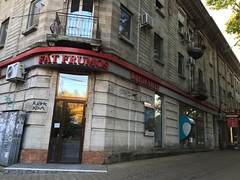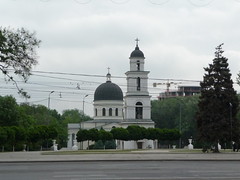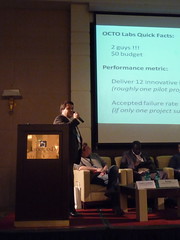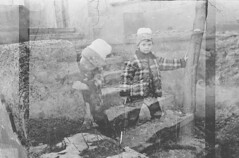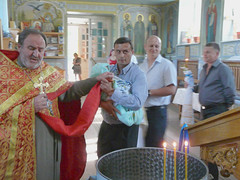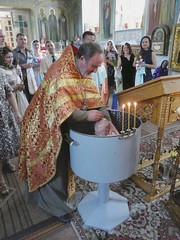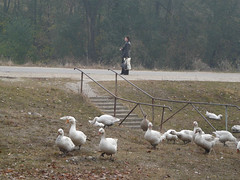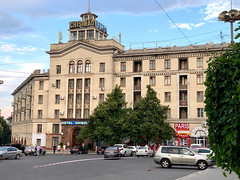Municipiul Chişinău
Chișinău (English: /ˌkɪʃᵻˈn/ , English: /ˌkʃˈn/ ; Romanian: [kiʃiˈnəw]), also rendered Kishinev (English: /ˈkɪʃᵻnɒf-nɛf/ , English: /-nɛv/ ; Russian: Кишинёв), is the capital and largest city of the Republic of Moldova. The city is Moldova's main industrial and commercial centre, and is located in the middle of the country, on the river Bîc, a tributary of the Dniester. According to the results of the 2014 census, the city proper had a population of 532,513, while the population of the Municipality of Chișinău (which includes the city itself and other nearby communities) was 700,000. Chișinău is the most economically prosperous locality in Moldova and its largest transportation hub. Nearly a third of Moldova's population lives in the metro area.
Etymology
The origin of the city's name is unclear. A theory suggests that the name may come from the archaic Romanian word (meaning "spring", "source of water") and ("new"), because it was built around a small spring, at the corner of Pușkin and Albișoara streets.
The other version, formulated by Ștefan Ciobanu, Romanian historian and academician, holds that the name was formed the same way as the name of Chișineu (alternative spelt as Chișinău) in Western Romania, near the border with Hungary. Its Hungarian name is , from which the Romanian name originates. Kisjenő comes from "small" and the Jenő, one of the seven Hungarian tribes that entered the Carpathian Basin in 896. At least 24 other settlements are named after the Jenő tribe.
Chișinău is known in Russian as (Russian: [kʲɪʂɨˈnʲɵf]), while Moldova's Russian-language media call it (Russian: [kʲɪʂɨˈnɛʊ]). It is written in the Latin Gagauz alphabet. It was also written as Chișineu in pre-20th-century Romanian and as in the Moldovan Cyrillic alphabet. Historically, the English-language name for the city, Kishinev, was based on the modified Russian one because it entered the English language via Russian at the time Chișinău was part of the Russian Empire (e.g. Kishinev pogrom). Therefore, it remains a common English name in some historical contexts. Otherwise, the Romanian-based Chișinău has been steadily gaining wider currency, especially in written language. The city is also historically referred to as German: Kischinau; Polish: Kiszyniów; Ukrainian: Кишинів; or Yiddish: קעשענעװ.
History
Moldavian period
Founded in 1436 as a monastery village, the city was part of the Principality of Moldavia (which, starting with the 16th century became a vassal state of the Ottoman Empire, but still retaining its autonomy). At the beginning of the 19th century Chișinău was a small town of 7,000 inhabitants.
Russian Imperial period
In 1812, in the aftermath of the Russo-Turkish War (1806–1812), the eastern half of Moldavia was ceded by the Ottomans to the Russian Empire. The newly acquired territories became known as Bessarabia.
Under Russian government, Chișinău became the capital of the newly annexed oblast (later guberniya) of Bessarabia. By 1834, an imperial townscape with broad and long roads had emerged as a result of a generous development plan, which divided Chișinău roughly into two areas: the old part of the town, with its irregular building structures, and a newer city centre and station. Between 26 May 1830 and 13 October 1836 the architect Avraam Melnikov established the Catedrala Nașterea Domnului with a magnificent bell tower. In 1840 the building of the Triumphal Arch, planned by the architect Luca Zaushkevich, was completed. Following this the construction of numerous buildings and landmarks began.
On 28 August 1871, Chișinău was linked by rail with Tiraspol, and in 1873 with Cornești. Chișinău-Ungheni-Iași railway was opened on 1 June 1875 in preparation for the Russo-Turkish War (1877–1878). The town played an important part in the war between Russia and Ottoman Empire, as the main staging area of the Russian invasion. During the Belle Époque, the mayor of the city was Carol Schmidt, considered one of Chișinău's best mayors. Its population had grown to 92,000 by 1862, and to 125,787 by 1900.
Pogroms and pre-revolution
In the late 19th century, especially due to growing anti-Semitic sentiment in the Russian Empire and better economic conditions in Moldova, many Jews chose to settle in Chișinău. By the year 1897, 46% of the population of Chișinău was Jewish, over 50,000 people.
As part of the pogrom wave organized in the Russian Empire, a large anti-Semitic riot was organized in the town on 19–20 April 1903, which would later be known as the Kishinev pogrom. The rioting continued for three days, resulting in 47 Jews dead, 92 severely wounded, and 500 suffering minor injuries. In addition, several hundred houses and many businesses were plundered and destroyed. Some sources say 49 people were killed. The pogroms are largely believed to have been incited by anti-Jewish propaganda in the only official newspaper of the time, Bessarabetz (Бессарабецъ). Mayor Schmidt disapproved of the incident and resigned later in 1903. The reactions to this incident included a petition to Tsar Nicholas II of Russia on behalf of the American people by US President Theodore Roosevelt in July 1903.
On 22 August 1905 another violent event occurred: the police opened fire on an estimated 3,000 demonstrating agricultural workers. Only a few months later, 19–20 October 1905, a further protest occurred, helping to force the hand of Nicholas II in bringing about the October Manifesto. However, these demonstrations suddenly turned into another anti-Jewish pogrom, resulting in 19 deaths.
Romanian period
Following the Russian October Revolution, Bessarabia declared independence from the crumbling empire, as the Moldavian Democratic Republic, before joining the Kingdom of Romania. As of 1919, Chișinău, with an estimated population of 133,000, became the second largest city in Romania.
Between 1918 and 1940, the center of the city undertook large renovation work. Romania granted important subsidies to its province and initiated large scale investment programs in the infrastructure of the main cities in Bessarabia, expanded the railroad infrastructure and started an extensive program to eradicate illiteracy.
In 1927, the Stephen the Great Monument, by the sculptor Alexandru Plămădeală, was erected. In 1933, the first higher education institution in Bessarabia was established, by transferring the Agricultural Sciences Section of the University of Iași to Chișinău, as the Faculty of Agricultural Sciences.
World War II
On 28 June 1940, as a direct result of the Molotov–Ribbentrop Pact, Bessarabia was annexed by the Soviet Union from Romania, and Chișinău became the capital of the newly created Moldavian Soviet Socialist Republic.
Following the Soviet occupation, mass deportations, linked with atrocities, were executed by the NKVD between June 1940 and June 1941. More than 400 people were summarily executed in Chișinău in July 1940 and buried in the grounds of the Metropolitan Palace, the Chișinău Theological Institute, and the backyard of the Italian Consulate, where the NKVD had established its headquarters. As part of the policy of political repression of the potential opposition to the Communist power, tens of thousand members of native families were deported from Bessarabia to other regions of the USSR.
A devastating earthquake occurred on 10 November 1940, measuring 7.4 (or 7.7, according to other sources) on the Richter scale. The epicenter of the quake was in the Vrancea Mountains, and it led to substantial destruction: 78 deaths and 2,795 damaged buildings (of which 172 were destroyed).
In June 1941, in order to recover Bessarabia, Romania entered World War II under the command of the German Wehrmacht, declaring war on the Soviet Union. Chișinău was severely affected in the chaos of the Second World War. In June and July 1941, the city came under bombardment by Nazi air raids. However, the Romanian and newly Moldovan sources assign most of the responsibility for the damage to Soviet NKVD destruction battalions, which operated in Chișinău until 17 July 1941, when it was captured by Axis forces.
During the German and Romanian military administration, the city suffered from the Nazi extermination policy of its Jewish inhabitants, who were transported on trucks to the outskirts of the city and then summarily shot in partially dug pits. The number of Jews murdered during the initial occupation of the city is estimated at 10,000 people. During this time, Chișinău, part of the Lăpușna County, was the capital of the newly established Bessarabia Governorate of Romania.
As the war drew to a conclusion, the city was once again the scene of heavy fighting as German and Romanian troops retreated. Chișinău was captured by the Red Army on 24 August 1944 as a result of the Second Jassy–Kishinev offensive.
Soviet period
After the war, Bessarabia was fully reintegrated into the Soviet Union, around 65 percent of its territory as the Moldavian SSR, while the remaining 35 percent was transferred to the Ukrainian SSR.
Two other waves of deportations of Moldova's native population were carried out by the Soviets, the first one immediately after the Soviet reoccupation of Bessarabia until the end of the 1940s, and the second one in the mid-1950s.
In the years 1947 to 1949, the architect Alexey Shchusev developed a plan with the aid of a team of architects for the gradual reconstruction of the city.
There was rapid population growth in the 1950s, to which the Soviet administration responded by constructing large-scale housing and palaces in the style of Stalinist architecture. This process continued under Nikita Khrushchev, who called for construction under the slogan "good, cheaper and built faster". The new architectural style brought about dramatic change and generated the style that dominates today, with large blocks of flats arranged in considerable settlements. These Khrushchev-era buildings are often informally called Khrushchyovka.
The period of the most signifi…
Looking for places related to Municipiul Chişinău?
Those are other destinations to find places related to Municipiul Chişinău:



